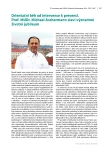-
Medical journals
- Career
Percutaneous approach for treating mitral regurgitation with mitral clip (MitraClip)
Authors: Michael Želízko; Vladimír Pořízka; Radka Kočková
Authors‘ workplace: Klinika kardiologie IKEM Praha, přednosta prof. MUDr. Josef Kautzner, CSc.
Published in: Vnitř Lék 2014; 60(12): 1090-1094
Category: 70. birthday prof. MUDr. Michael Aschermann, DrSc., FESC, FACC
Overview
Mitral regurgitation (MR) is the second most commonly encountered valvular lesion and it has been positively correlated with the subsequent development of heart failure and death. MitraClip therapy is a new percutaneous approach for treating mitral regurgitation which involves mechanical edge-to-edge coaptation of the mitral leaflets that is analogous to the surgical Alfieri technique. Indication for MitraClip in patients with severe degenerative or functional mitral regurgitation is based on clinical symptoms (NYHA II-IV) and specific anatomic criteria including a primary central regurgitant jet associated with the A2/P2 segments, in functional MR a coaptation length ≥ 2 mm, a coaptation depth ≤ 11 mm, in degenerative MR a flail gap <10 mm, and a flail width < 15 mm. Key exclusion criteria included LVEF ≤ 25%, LV end-systolic dimension > 55 mm, mitral valve orifice area < 4 cm2, recent myocardial infarction or endocarditis. The safety profile of the procedure appears to be excellent. Acute outcomes are favourable, and mid-term durability (up to 2years) is reasonable. Patients who are older, at higher risk for surgical therapy, or with functional mitral regurgitation (FMR) and depressed ejection fractions will constitute the initial target population for MitraClip therapy. Since FMR is primarily a ventricular problem, it remains to be seen whether a leaflet intervention will have durable efficacy.
Key words:
indication criteria – mitral regurgitation – mitral clip (MitraClip) – exclusion criteria
Sources
1. Nkomo VT, Gardin JM, Skelton TN et al. Burden of valvular heart diseases: a population-based study. Lancet 2006; 368(9540): 1005–1011.
2. Bursi F, Enriquez-Sarano M, Nkomo VT et al. Heart failure and death after myocardial infarction in the community: the emerging role of mitral regurgitation. Circulation 2005; 111(3): 295–301.
3. Robbins JD, Maniar PB, Cotts W et al. Prevalence and severity of mitral regurgitation in chronic systolic heart failure. Am J Cardiol 2003; 91(3): 360–362.
4. Trichon BH, Felker GM, Shaw LK et al. Relation of frequency and severity of mitral regurgitation to survival among patients with left ventricular systolic dysfunction and heart failure. Am J Cardiol 2003; 91(5): 538–543.
5. Zamorano JL, Gonzales-Gomez A, Lancellotti P. Mitral valve anatomy: implications for transcatheter mitral valve interventions. Eurointervention 2014; 10(Suppl U): U106-U111.
6. Alfieri O, Maisano F, De Bonis M et al. The double-orifice technique in mitral valve repair: a simple solution for complex problems. J Thorac Cardiovasc Surg 2001; 122(4): 674–681.
7. Rogers JH, Franzen O. Percutaneous edge-to-edge MitraClip therapy in the management of mitral regurgitation. Eur Heart J 2011; 32(19): 2350–2357.
8. Feldman T, Kar S, Rinaldi M et al. Percutaneous mitral repair with the MitraClip system: safety and midterm durability in the initial EVEREST (Endovascular Valve Edge-to-Edge REpair Study) Cohort. J Am Coll Cardiol 2009; 54(8): 686–694.
9. Feldman T, Foster E, Glower DG et al. Percutaneous repair or surgery for mitral regurgitation. N Engl J Med 2011; 364(15): 1395–1406.
10. Feldman T, Mauri L, Kar S et al. EVEREST II Randomized Clinical Trial: a Critical Assessment of the Safety Data In Patients Treated with the MitraClip. J Am Coll Cardiol 2010; 56(Suppl 1): B23.
11. Franzen O, Baldus S, Rudolph V et al. Acute outcomes of MitraClip therapy for mitral regurgitation in high-surgical-risk patients: emphasis on adverse valve morphology and severe left ventricular dysfunction. Eur Heart J 2010; 31(11): 1373–1381.
12. Tamburino C, Ussia GP, Maisano F et al. Percutaneous mitral valve repair with the MitraClip system: acute results from a real world setting. Eur Heart J 2010; 31(11): 1382–1389.
13. Herrmann HC, Kar S, Siegel R et al. Effect of percutaneous mitral repair with the MitraClip device on mitral valve area and gradient. EuroIntervention 2009; 4(4): 437–442.
Labels
Diabetology Endocrinology Internal medicine
Article was published inInternal Medicine

2014 Issue 12-
All articles in this issue
-
Orienteering from intervention to prevention.
Prof. Michael Aschermann celebrates life jubilee - Prof. Michael Aschermann, MD, DSc, FESC, FACC, life jubilee
- Anticoagulant therapy in secondary prevention of coronary events
-
Anaemia and iron deficiency in clinical practice:
from cardiology to gastroenterology and beyond - Embolic ischemic strokes
- Will the new SGLT2 inhibitor empagliflozin help us reduce the risk of hypoglycemia?
- Past and present issues of the pulmonary circulation in the General University Hospital in Prague
- Catheter ablation of focus triggering ventricular fibrillation in patients with structural heart disease
- Current status of intravascular ultrasound in interventional cardiology
- Obesity and heart
- Carotid artery stenting – history, trends and innovations
- Do natriuretic peptides have a new chance in treatment of heart failure?
-
Renal denervation in patients with resistant hypertension:
is it still possible to resuscitate? - Modern treatment of acute ischemic stroke
- Percutaneous approach for treating mitral regurgitation with mitral clip (MitraClip)
- IMProved Reduction of Outcomes: Vytorin Efficacy International Trial (studie IMPROVE-IT)
-
Orienteering from intervention to prevention.
- Internal Medicine
- Journal archive
- Current issue
- Online only
- About the journal
Most read in this issue- Percutaneous approach for treating mitral regurgitation with mitral clip (MitraClip)
-
Anaemia and iron deficiency in clinical practice:
from cardiology to gastroenterology and beyond - Embolic ischemic strokes
- Obesity and heart
Login#ADS_BOTTOM_SCRIPTS#Forgotten passwordEnter the email address that you registered with. We will send you instructions on how to set a new password.
- Career

